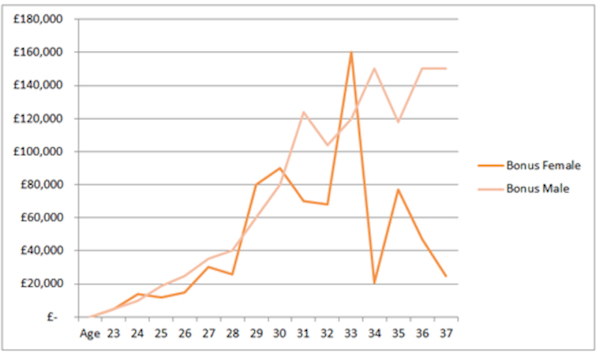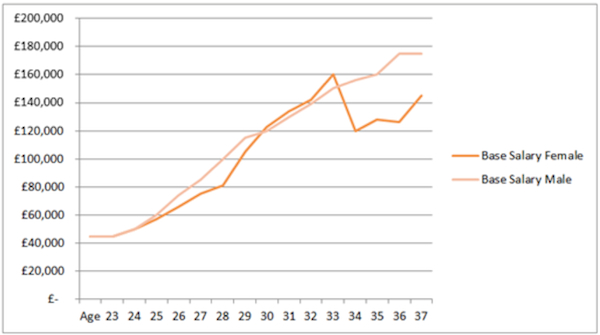The banking industry’s gender-based wage gap has narrowly favored women as they advance past entry-level positions—according to salary benchmarking firm Emolument—but only up to point.
That point, specifically: 32 or 33 years of age.
Between a woman’s 32nd and 37th birthdays, based on median survey data, she could expect her base salary to drop 11% and total compensation to fall 15%. It attributed the sharp fall in women’s pay to their tendency to have families.
“In the late 20s and early 30s, women not only keep up [to] but outperform men,” the firm described. “And then maternity leave hits!”
 Source: Emolument
Source: Emolument
Early 30s females reported the highest median bonus—£160,000 ($257,000)—of the entire sample of London-based bankers aged 37 and younger. But women just a couple of years older earned incentive payouts on par with 25-year-old men (£20,000).
Base salary dropped less dramatically than bonuses, and showed signs of recovery as women entered their late 30s. From a sample-wide high of £160,000 for 32-year-old female bankers, median pay fell to £120,000 for those in their mid-30s—roughly equivalent to that of a 30-year-old of either gender. By age 37, women’s base pay had ticked up past £140,000.
 Source: Emolument
Source: Emolument
Emolument drew this data from figures collected from 2,780 industry professionals’ anonymously reported salary and bonus figures for this year and last year. Women accounted for roughly 10% of bankers in Europe and 11% in America, although that portion falls to 6% and 8% respectively at the managing director level.
“Clearly the banking industry still has a long way to go when it comes to gender parity,” remarked Emolument’s CEO Robert Benson. “Most concerning are not necessarily salary figures but rather female/male population ratios from the very early stages of a career in finance.”
Related Content:The Missing Women of Asset Management
